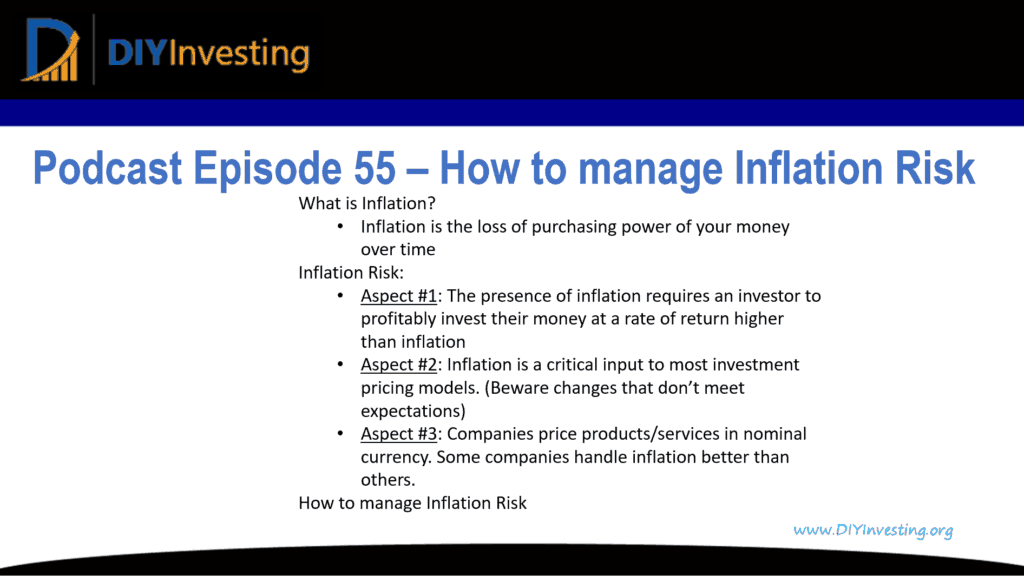Mental Models discussed in this podcast:
- Inflation
- Mr. Market
- Purchasing Power
- Pricing Power
- Discount Rates
- Risk Premium
Please review and rate the podcast
If you enjoyed this podcast and found it helpful, please consider leaving me a rating and review. Your feedback helps me to improve the podcast and grow the show’s audience.
Follow me on Twitter and YouTube
Twitter Handle: @TreyHenninger
YouTube Channel: DIY Investing
Support the Podcast on Patreon
This is a podcast supported by listeners like you. If you’d like to support this podcast and help me to continue creating great investing content, please consider becoming a Patron at DIYInvesting.org/Patron.
You can find out more information by listening to episode 11 of this podcast.
Show Outline

What is inflation?
- Inflation has many definitions depending upon your source and audience. However, for investors only one definition matters.
- Inflation is the loss of purchasing power of your money over time.
Inflation Risk
- Key Aspect #1: The simple presence of inflation requires an investor to profitably invest their money at a rate of return higher than inflation. Therefore, inflation risk, on the one hand, can mean that investors have a constant need to invest otherwise their money loses value.
- Key Aspect #2: Inflation is a critical input to many theoretical investment pricing models. Whether explicit or implicit, investors around the world make assumptions about future inflation when choosing what investments to make.
- If future inflation does not match these expectations substantial changes in the price of securities (including stocks and bonds) may occur.
- Key Aspect #3: Companies price their products and services in nominal currency. (This coat costs $100 USD or $100 EUR). They don’t price goods in real terms, like “4 hrs of labor” or “8 hrs of labor.”
- As inflation occurs some companies will be able to raise their prices. Others won’t be able to.
- This means that companies will generally fall into 3 categories in the presence of inflation:
- Category 1: As their costs rise, the company is unable to pass on these costs to their customers. Therefore, the company becomes less profitable.
- Examples: Commodity companies
- Category 2: As their costs rise, the company is able to pass on these costs to their customers. Therefore, the company can maintain profitability in the face of inflation.
- Examples: Media companies, TIPS, NACCO
- Category 3: As their costs rise, the company is able to raise their prices at a rate faster than inflation. Therefore, the company can become more profitable during periods of inflation. Sometimes known as Defense Companies, High-Quality Companies, or Blue Chips.
- Examples: Tobacco Companies, Banks,
- Category 1: As their costs rise, the company is unable to pass on these costs to their customers. Therefore, the company becomes less profitable.
- Category 1 & 2 are much more common.
How to manage Inflation Risk
- In times of high inflation, be aware that low inflation may return in the future. You can sometimes lock in high rates of return on low-risk investments when others only anticipate ever-higher inflation forever.
- In times of low inflation, don’t forget that high inflation is always a possibility. Position yourself to own companies that can thrive in both low and high inflation. Don’t simply latch onto those companies that only thrive in low inflation environments. Pricing power is critical to successful investing.
Summary:
Your goal as an investor it to earn an acceptable return on your investment capital over your investing lifetime. The very minimum must be to at least earn a return that exceeds the rate of inflation. Ideally, you’ll earn a risk premium above inflation. In today’s investing environment, low inflation is the accepted norm and many predict low inflation far into the future. Perhaps one of your biggest opportunities is to, therefore, find and invest in the subset of companies that will thrive when high inflation returns. When the rest of the market gets hammered, your investments would be safe.
